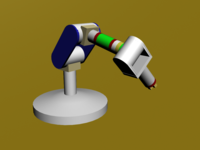
Photo from wikipedia
During rhythmic pointing movements, degrees of freedom (DOF) in the human action system—such as joint-angles in the arm—are assumed to covary to stabilise end-effector movement, e.g. index finger. In this… Click to show full abstract
During rhythmic pointing movements, degrees of freedom (DOF) in the human action system—such as joint-angles in the arm—are assumed to covary to stabilise end-effector movement, e.g. index finger. In this paper, it is suggested that the end-effector movement and the coordination of DOF are reciprocally related in synergies that link DOF so as to produce the end-effector movement. The coordination of DOF in synergies and the relation between end-effector movement and DOF coordination received little attention, though essential to understand the principles of synergy formation. Therefore, the current study assessed how the end-effector movement related to the coordination of joint-angles during rhythmic pointing across target widths and distances. Results demonstrated that joint-angles were linked in different synergies when end-effector movements differed across conditions. Furthermore, in every condition, three joint-angles (shoulder plane of elevation, shoulder inward-outward rotation, elbow flexion-extension) largely drove the end-effector, and all joint-angles contributed to covariation that stabilised the end-effector. Together, results demonstrated synergies that produced the end-effector movement, constrained joint-angles so that they covaried to stabilise the end-effector, and differed when end-effector movement differed. Hence, end-effector and joint-angles were reciprocally related in synergies—indicating that the action system was organised as a complex dynamical system.
Journal Title: Scientific Reports
Year Published: 2019
Link to full text (if available)
Share on Social Media: Sign Up to like & get
recommendations!